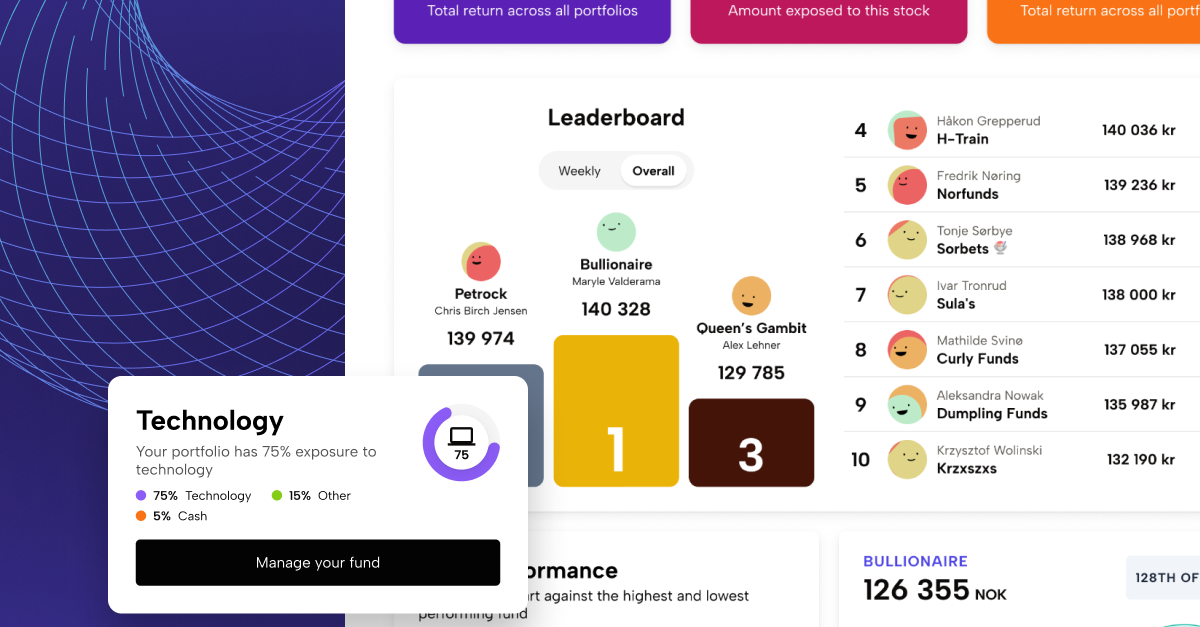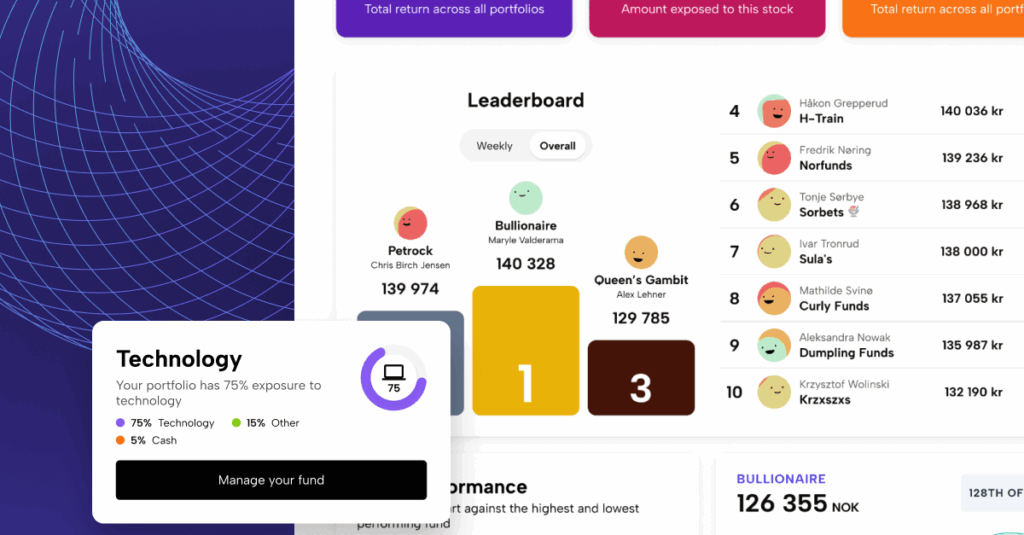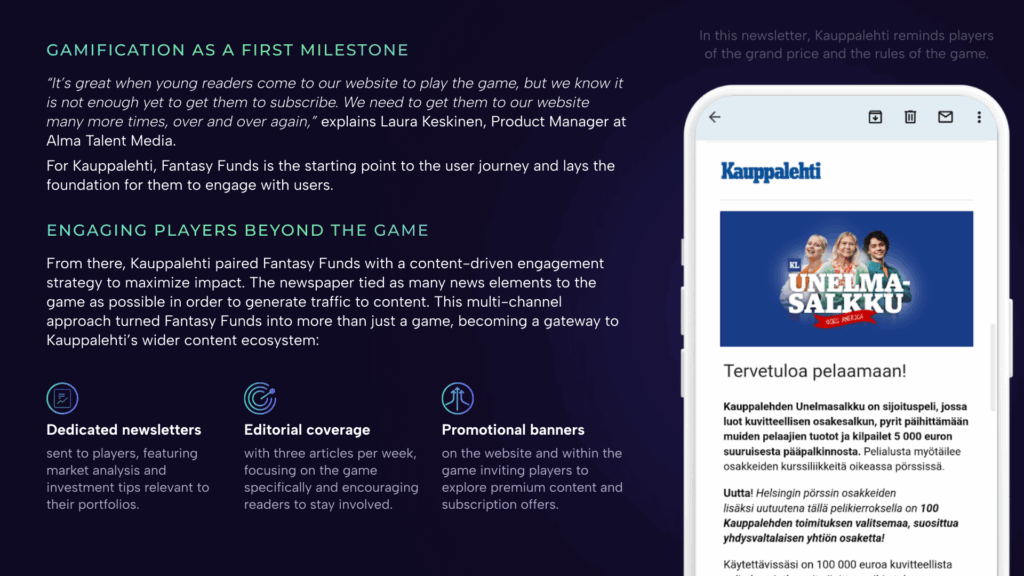How Stock Market Games for Media Publishers Engage Readers

Gamification has become a powerful strategy, reshaping how people learn, engage, and make financial decisions. From fitness apps like Strava to language platforms like Duolingo, industries worldwide have embraced game mechanics to encourage daily habits and long-term behavioral change.
With gamification’s proven success and a surge in interest for personal finance, younger generations are increasingly eager to manage their money, navigate the stock market, and grow their portfolios, while avoiding common risks and pitfalls.
For publishers and media brands, this growing appetite for financial literacy presents a unique opportunity. How can they create engaging, educational experiences that meet readers where they are? This is where stock market games come into play: an innovative, interactive approach that is helping media outlets attract younger audiences and drive subscriptions by bridging the game with financial journalism.
Reaching Younger Readers: How Publishers Engage the Next Generation
To attract younger audiences, publishers across Europe have deployed targeted strategies to make stock market games more visible and approachable.
In Norway, Dagens Næringsliv (DN) partnered with business schools and financial education institutions to promote its stock market game to students. They also lowered the entry threshold to include 16–18-year-olds, resulting in nearly 770 players under 18 joining the game. DN found that the social aspect of their game, such as the creation of leagues where friends and classmates compete, were a major draw and becoming the first reason to join the game over the possibility to win prizes. Over six seasons, 50–60% of their player base consistently fell under the age of 35, proving their stock market game’s strategical success.
Finland’s Kauppalehti took a different route, leaning heavily on digital marketing and social media platforms like TikTok, Instagram, YouTube, and even banners in university cafeterias. Collaborations with influencers added an authentic touch: one content creator documented their own Fantasy Funds journey, creating videos that were widely shared across TikTok and Instagram. The introductory video alone became a breakout hit, helping make the game feel accessible and fun. This multi-channel approach ensured the stock market game resonated with students and built momentum across platforms.
Why Gamification Works: The Psychology Behind Play
At its core, gamification taps into three innate human drives that align perfectly with personal finance learning:
The Desire to Progress
Younger audiences want to see tangible results from their efforts. Visible milestones—like leaderboards, badges, and levels—mirror the satisfaction of tracking investments or hitting savings goals. In a stock market game, players can watch their virtual portfolios grow, giving them a sense of accomplishment and motivating them to keep engaging.
The Need for Social Connection
For Gen Z and millennials, learning often happens in communities—whether on Discord channels, group chats, or social platforms. A stock market game adds this social layer with private leagues, friend challenges, and shared achievements that encourage healthy competition and collaboration.
The Pull of Curiosity and Fun
Traditional financial content can feel dry or overwhelming. Gamification removes those barriers by transforming complex topics like portfolio diversification or market volatility into approachable, risk-free experiences. Players can experiment without fear of real-world consequences, helping them gain confidence to eventually take control of their finances.
Apps like Duolingo and Klarna’s Money Mission prove this works. Duolingo boosted daily retention from 12% to over 55% with gamified elements, while Klarna kept 40–60% of users returning daily to learn budgeting skills.
The Rise of Financial Literacy and Stock Market Simulators
People today and younger users in particular are entering a world of unprecedented financial complexity, with cryptocurrencies, ETFs, volatile markets and geopolitical influential factors – but also unprecedented access. Budgeting apps, low-cost trading platforms, and even social media have democratized financial knowledge. Yet a 2024 OECD study shows only 33% of young adults feel confident managing their money.
This is where stock market games step in. By turning passive reading into active learning, they give users a sandbox to explore investments, try out strategies, and learn from mistakes, without risking actual savings.
One such stock market games is Fantasy Funds, an INMA and Wan-Ifra award-winning game built on successful game mechanisms. The game enables players to:
- Build and manage virtual stock portfolios using real-time market data
- Leverage the social community aspects by enabling the creation of leagues amongst friends and colleagues
- Participate in stock market challenges and competitions for weekly and season-long prizes to motivate engagement.
- Get introduced to financial journalistic content integrated across the game, such as financial articles, videos, financial podcasts and personalized newsletters tied directly to the game.
For publishers, Fantasy Funds has become a core part of their strategy for audience growth, retention, and monetization.
Success Stories: Publishers Tapping Into Financial Curiosity
Kauppalehti (Finland)
Finland’s leading business newspaper launched Fantasy Funds to attract younger and more diverse audiences. Within five weeks:
- 24,000 players registered.
- 24% of players were women (over double the average for financial media).
- Significant growth among 18–34 year-old readers.
As Alma Talent Media’s Laura Keskinen explains:
“It’s great when young readers come to our website to play the game, but we know it’s not enough yet to get them to subscribe. We need to build returning reader habits and create an inner motivation to subscribe.”
Dagens industri (Sweden)
By capitalizing on rising interest in the stock market, Dagens industri, part of Bonnier, saw:
- 17,000 player registrations.
- 21,000 portfolios created.
- Session times 2.5x longer during the game period.
This engagement also led to higher ad impressions and subscriber conversions.
Finanz und Wirtschaft (Switzerland)
For Finanz und Wirtschaft, Fantasy Funds generated 88% of new users and ultimately led to a subscriptions growth by 22% during the game. Sponsorships offset operational costs, underlining the commercial viability of a stock market game for publishers.
Building Long-Term Financial Confidence
Stock market games don’t just attract clicks; they help build lasting habits. Integrated content strategies—such as newsletters with investment tips and articles tied to game progress—keep players engaged beyond the leaderboard.
The social elements are equally powerful. Private leagues and community challenges tap into younger readers’ desire for shared experiences, making financial education feel less like homework and more like a game night with friends.
Why Stock Market Games Matter
For Gen Z and millennials, financial literacy is a priority. For publishers, it’s a chance to meet them with innovative, interactive tools that drive engagement and revenue.
Stock market games like Fantasy Funds are more than engagement tactics. They’re gateways to financial confidence for readers and catalysts for growth for media brands.
Ready to engage the next generation of investors?
Download The Power of Gamification e-book to see how stock market games can transform your audience strategy!





